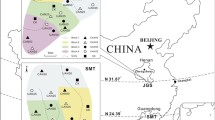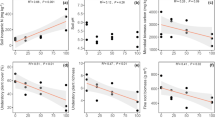Abstract
Forest floor vegetation is an important component of forest biodiversity, and numerous studies have shown that N input alters the vegetation. In some cases, however, the effects of experimental N addition have been small or absent. Two alternative hypotheses have been suggested: (a) competition from the tree layer confounds the response to N, or (b) N response in areas with high background deposition is limited by N saturation. Neither of these hypotheses has so far been explicitly tested. Here, we compile data on forest floor vegetation from N addition experiments, in which the forest had been clear-cut, along an N deposition gradient ranging from 4 to 16 kg ha−1 year−1 in Sweden. We analyzed the effects of N addition and its interaction with N deposition on common species and thereby tested the second hypothesis in an environment without the confounding effects of the tree layer. The results show that the effects of the experimental N addition are significantly influenced by background N deposition: the N addition effects are smaller in areas with high N deposition than in areas with low N deposition, despite the fact that the highest N deposition in this study can be considered moderate from an international perspective. The results are important when assessing the reliability of results from N addition experiments on forest floor vegetation in areas with moderate to high background N deposition. We conclude that the interacting effects of N addition and N deposition need to be included when assessing long-term N sensitivity of plant communities.





Similar content being viewed by others
References
Aber JD, Nadelhoffer KJ, Steudler P, Melillo JM (1989) Nitrogen saturation in northern forest ecosystems. BioSci 39:378–386
Akselsson C, Belyazid S, Hellsten S, Klarqvist M, Pihl-Karlsson G, Karlsson P-E, Lundin L (2010) Assessing the risk of N leaching from forest soils across a steep N deposition gradient in Sweden. Environ Pollut 158:3588–3595
Bergh J, Linder S, Lundmark T, Elfving B (1999) The effect of water and nutrient availability on the productivity of Norway spruce in northern and southern Sweden. For Ecol Manage 119:51–62
Bergh J, Nilsson U, Grip H, Hedwall P-O, Lundmark T (2008) Effects of frequency of fertilisation on production, foliar chemistry and nutrient leaching in young Norway spruce stands in Sweden. Silv Fenn 42:721–733
Bobbink R, Hicks K, Galloway J, Spranger T, Alkemade R, Ashmore M, Bustamante M, Cinderby S, Davidson E, Dentener F, Emmett B, Erisman J-W, Fenn M, Gilliam F, Nordin A, Pardo L, De Vries W (2010) Global assessment of nitrogen deposition effects on terrestrial plant diversity: a synthesis. Ecol Appl 20:30–59
Bobbink R, Braun S, Nordin A, Power S, Schutz K, Strengbom J, Weijters M, Tomassen H (2011) Review and revision of empirical critical loads and dose-response relationships. Coordination Centre for Effects (CCE), Bilthoven, The Netherlands
De Schrijver A, De Frenne P, Ampoorter E, Van Nevel L, Demey A, Wuyts K, Verheyen K (2011) Cumulative nitrogen input drives species loss in terrestrial ecosystems. Glob Ecol Biogeogr 20:803–816
Dentener F, Drevet J, Lamarque JF, Bey I, Eickhout B, Fiore AM, Hauglustaine D, Horowitz LW, Krol M, Kulshrestha UC, Lawrence M, Galy-Lacaux C, Rast S, Shindell D, Stevenson D, Van Noije T, Atherton C, Bell N, Bergman D, Butler T, Cofala J, Collins B, Doherty R, Ellingsen K, Galloway J, Gauss M, Montanaro V, Müller JF, Pitari G, Rodriguez J, Sanderson M, Solmon F, Strahan S, Schultz M, Sudo K, Szopa S, Wildi O (2006) Nitrogen and sulfur deposition on regional and global scales: a multimodel evaluation. Glob Biogeochem Cycl 20:GB4003
Dralle K, Larsen JB (1995) Growth response to different NPK-fertilizer in Norway spruce plantations in Western Denmark. Plant Soil 168–169:501–504
Ellenberg H, Weber HE, Düll R, Wirth V, Werner W (2001) Zeigerwerte von Pflanzen in Mitteleuropa (in German with English summary). Scr Geobot 18:1–258
Emmett BA (2007) Nitrogen saturation of terrestrial ecosystems: some recent findings and their implications for our conceptual framework. Water Air Soil Pollut Focus 7:99–109
Eriksson H, Karlsson K (1997) Effects of different thinning and fertilization regimes on the development of Scots pine (Pinus sylvestris L.) and Norway spruce (Picea abies (L.) Karst.) stands in long-term silvicultural trials in Sweden (in Swedish with English summary). Report 42. Swedish University of Agricultural Sciences, Department of Forest Yield Research
Gilliam FS (2006) Response of the herbaceous layer of forest ecosystems to excess nitrogen deposition. J Ecol 94:1176–1191
Gilliam FS (2007) The ecological significance of the herbaceous layer in temperate forest ecosystems. Bioscience 57:845–858
Gilliam FS, Hockenberry AW, Adams MB (2006) Effects of atmospheric nitrogen deposition on the herbaceous layer of a central Appalachian hardwood forest. J Torr Bot Soc 133:240–254
Gross KL, Willig MR, Gough L, Inouye R, Cox SB (2000) Patterns of species density and productivity at different spatial scales in herbaceous plant communities. Oikos 89:417–427
Hannerz M, Hånell B (1997) Effects on the flora in Norway spruce forests following clearcutting and shelterwood cutting. For Ecol Manage 90:29–49
Hedwall P-O, Nordin A, Brunet J, Bergh J (2010) Compositional changes of forest-floor vegetation in young stands of Norway spruce as an effect of repeated fertilisation. For Ecol Manage 259:2418–2425
Hedwall P-O, Brunet J, Nordin A, Bergh J (2013) Changes in the abundance of keystone forest-floor species in response to changes of forest structure. J Veg Sci 24:296–306
Högberg P, Fan H, Quist M, Binkley D, Tamm CO (2006) Tree growth and soil acidification in response to 30 years of experimental nitrogen loading on boreal forest. Glob Chang Biol 12:489–499
Hurd TM, Brach AR, Raynal DJ (1998) Response of understory vegetation of Adirondack forests to nitrogen additions. Can J For Res 28:799–807
Huston MA (1999) Local processes and regional patterns: appropriate scales for understanding variation in the diversity of plants and animals. Oikos 86:393–401
Hyvönen R, Persson T, Andersson S, Olsson B, Ågren GI, Linder S (2008) Impact of long-term nitrogen addition on carbon stocks in trees and soils in northern Europe. Biogeochemistry 89:121–137
Jonasson S (1988) Evaluation of the point intercept method for the estimation of plant biomass. Oikos 52:101–106
Korhonen JFJ, Pihlatie M, Pumpanen J, Aaltonen H, Hari P, Levula J, Kieloaho A-J, Nikinmaa E, Vesala T, Ilvesniemi H (2012) Nitrogen balance of a boreal Scots pine forest. Biogeosci Discuss 9:11202–11237
Melillo JM, McGuire AD, Kicklighter AW, Moore B III, Vorosmarty CJ, Schloss AL (1993) Global climate change and terrestrial net primary production. Nature 363:234–240
Nilsson MC, Wardle DA (2005) Understory vegetation as a forest ecosystem driver: evidence from the northern Swedish boreal forest. Front Ecol Environ 3:421–428
Nordin A, Strengbom J, Ericson L (2006) Responses to ammonium and nitrate additions by boreal plants and their natural enemies. Environ Pollut 141:167–174
Oberle B, Grace JB, Chase JM (2009) Beneath the veil: plant growth form influences the strength of species richness-productivity relationships in forests. Glob Ecol Biogeogr 18:416–425
Odell G, Ståhl G (1998) Vegetationsförändringar i svensk skogsmark mellan 1980- och 90-talet—En studie grundad på Ståndortskarteringen (in Swedish). Rapport 37. Sveriges lantbruksuniversitet, institutionen för skoglig resurshushållning och geomatik
Oksanen J, Blanchet FG, Kindt R, Legendre P, O’Hara RB, Simpson GL, Solymos P, Stevens MHM, Wagner H (2011) Vegan: community ecology package. R package version 1.17-8. http://CRAN.R-project.org/package=vegan
Olsson BA, Kellner O (2006) Long-term effects of nitrogen fertilization on ground vegetation in coniferous forests. For Ecol Manage 238:458–470
Olsson P, Linder S, Giesler R, Högberg P (2005) Fertilization of boreal forest reduces both autotrophic and heterotrophic soil respiration. Glob Chang Biol 11:1745–1753
Palviainen M, Finér L, Mannerkovski H, Piirainen S, Starr M (2005) Responses of ground vegetation species to clear-cutting in a boreal forest: aboveground biomass and nutrient contents during the first 7 years. Ecol Res 20:652–660
Pärtel M, Laanisto L, Zobel M (2007) Contrasting plant productivity-diversity relationships across latitude: the role of evolutionary history. Ecology 88:1091–1097
Phoenix GK, Emmett BA, Britton AJ, Caporn SJM, Dise NB, Helliwell R, Jones L, Leake JR, Leith ID, Sheppard LJ, Sowerby A, Pilkington MG, Rowe EC, Ashmore MR, Power SA (2012) Impacts of atmospheric nitrogen deposition: responses of multiple plant and soil parameters across contrasting ecosystems in long-term field experiments. Glob Chang Biol 18:1197–1215
R Development Core Team (2011) R: a language and environment for statistical computing. R Foundation for Statistical Computing, Vienna. http://www.R-project.org/
Röttgermann M, Steinlein T, Beyschlag W, Dietz H (2000) Linear relationships between aboveground biomass and plant cover in low open herbaceous vegetation. J Veg Sci 11:145–148
SMHI (2010) Temperatursummor och humiditet för växtsäsongen 1980–2009
SMHI (2011) Nationell kartläggning av atmosfärskemiska data för Sveriges miljöövervakning, version Atmosfärskemi 2011.1, framtaget av SMHI på uppdrag av Naturvårdsverket. http://www.smhi.se/klimatdata/miljo/atmosfarskemi
Strengbom J, Nordin A (2008) Commercial forest fertilisation causes long-term residual effects in ground vegetation of boreal forests. For Ecol Manage 256:2175–2781
Strengbom J, Nordin A (2012) Physical disturbance determines effects from nitrogen addition on ground vegetation in boreal coniferous forests. J Veg Sci 23:361–371
Strengbom J, Walheim M, Näsholm T, Ericson L (2003) Regional differences in the occurrence of understorey species reflect nitrogen deposition in Swedish forests. Ambio 32:91–97
Tamm CO (1991) Nitrogen in terrestrial ecosystems. Questions of productivity, vegetational change and ecosystem stability. Ecol Stud 81:1–116
Venables WN, Ripley BD (2002) Modern applied statistics with S, 4th edn. Springer, New York
Verheyen K, Baeten L, De Frenne P, Bernhardt-Römermann M, Brunet J, Cornelis J, Decocq G, Dierschke H, Eriksson O, Hédl R, Heinken T, Hermy M, Hommel P, Kirby K, Naaf T, Peterken G, Petřík P, Pfadenhauer J, Van Calster H, Walther G-R, Wulf M, Verstraeten G (2011) Driving factors behind the eutrophication signal in understorey plant communities of deciduous temperate forests. J Ecol 100:352–365
Acknowledgments
We thank Goddert von Oheimb and two anonymous reviewers for valuable comments on an earlier version of this manuscript. This research was funded through Future Forests, a multidisciplinary research program supported by the Foundation for Strategic Environmental Research (MISTRA), the Swedish Forestry Industry, the Swedish University of Agricultural Sciences (SLU), Umeå University and the Forestry Research Institute of Sweden, and by grants from Stiftelsen Oscar och Lili Lamms Minne, the Swedish Research Council for Environment, Agricultural Sciences and Spatial Planning (FORMAS), Carl Tryggers Stiftelse för Vetenskaplig Forskning, and Erik Rönnbergs Fond. The experiments comply with the current laws of the country (Sweden) in which the experiments were performed.
Author information
Authors and Affiliations
Corresponding author
Additional information
Communicated by Laura Gough.
Rights and permissions
About this article
Cite this article
Hedwall, P.O., Nordin, A., Strengbom, J. et al. Does background nitrogen deposition affect the response of boreal vegetation to fertilization?. Oecologia 173, 615–624 (2013). https://doi.org/10.1007/s00442-013-2638-3
Received:
Accepted:
Published:
Issue Date:
DOI: https://doi.org/10.1007/s00442-013-2638-3




